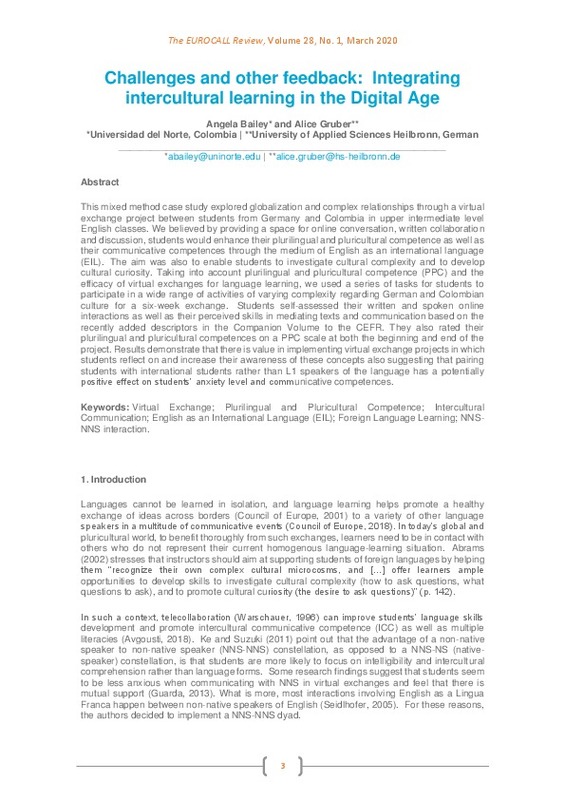Abrams, Z.I. (2002). Surfing to cross-cultural awareness: Using Internet-mediated projects to explore cultural stereotypes. Foreign Language Annals, 35(2), 141- 160. https://doi.org/10.1111/j.1944-9720.2002.tb03151.x
Avgousti, M. I. (2018) Intercultural communicative competence and online exchanges: a systematic review. Computer Assisted Language Learning, 31(8), 819853. https://doi.org/10.1080/09588221.2018.1455713
Belz, J.A. (2003). Linguistic perspectives on the development of intercultural competence in telecollaboration. Language Learning & Technology, 7 (2), 68-117. http://dx.doi.org/10125/25201
[+]
Abrams, Z.I. (2002). Surfing to cross-cultural awareness: Using Internet-mediated projects to explore cultural stereotypes. Foreign Language Annals, 35(2), 141- 160. https://doi.org/10.1111/j.1944-9720.2002.tb03151.x
Avgousti, M. I. (2018) Intercultural communicative competence and online exchanges: a systematic review. Computer Assisted Language Learning, 31(8), 819853. https://doi.org/10.1080/09588221.2018.1455713
Belz, J.A. (2003). Linguistic perspectives on the development of intercultural competence in telecollaboration. Language Learning & Technology, 7 (2), 68-117. http://dx.doi.org/10125/25201
Council of Europe (2001), Common European Framework of Reference for Languages: Learning, Teaching, Assessment. Cambridge: Cambridge University Press. Retrieved from https://www.coe.int/en/web/common-european-framework-reference-languages
Council of Europe (2018), Common European Framework of Reference for Languages: Learning, Teaching, Assessment. Companion Volume with New Descriptors. Strasbourg: Council of Europe. Retrieved from https://rm.coe.int/cefr-companion-volumewith-new-descriptors2018/1680787989
Fuchs, C., Hauck, M., & Müller-Hartmann, A. (2012). Promoting learner autonomy through multiliteracy skills development in cross-institutional exchanges. Language Learning & Technology, 16(3), 82-102. Retrieved from http://llt.msu.edu/issues/october2012/fuchsetal.pdf
Galante, A. (2018). Plurilingual or monolingual? A mixed methods study investigating plurilingual instruction in an EAP program at a Canadian university. (Doctoral dissertation) Retrieved from https://tspace.library.utoronto.ca/handle/1807/91806
Gläsman, S. (2004). Communication online. Bedfordbury: CILT.
Guarda, M. (2013). Negotiating a transcultural place in an English as a lingua franca telecollaboration exchange. (Unpublished PhD thesis). Retrieved from http://paduaresearch.cab.unipd.it/5337/1/guarda_marta_tesi.pdf
Helm, F. (2015). The practices and challenges of telecollaboration in higher education in Europe. Language Learning & Technology, 19(2), 197-217. Retrieved from http://llt.msu.edu/issues/june2015/helm.pdf
Ke, I. C., & Suzuki, T. (2011). Teaching global English with NNS-NNS online communication. Journal of Asia TEFL, 8(2), 169-188. Retrieved from https://waseda.pure.elsevier.com/en/publications/teaching-global-english-with-nns-nnsonline-communication
Müller-Hartmann, A., O'Dowd, R., and colleagues from the EVALUATE team (2017). A training manual on telecollaboration for teacher trainers. Retrieved from https://www.evaluateproject.eu/evlt-data/uploads/2017/09/TrainingManual_EVALUATE.pdf
Pellettieri, J. (2000). Negotiation in cyberspace: The role of chatting in the development of grammatical competence. In Warschauer, M. & Kern, R. (dir.). Network-based language teaching: Concepts and practice. Cambridge: Cambridge University Press. 59-87. https://doi.org/10.1017/CBO9781139524735.006
Schenker, T. (2017). Synchronous telecollaboration for novice language learners: Effects on speaking skills and language learning interests. Alsic, 20(2). https://doi.org/10.4000/alsic.3068
Seidlhofer, B. (2005). English as a lingua franca, ELT Journal, 59, 339-41. https://doi.org/10.1093/elt/cci064
Tian, J. & Wang, Y. (2010). Taking language learning outside the classroom: Learners' perspectives of eTandem learning via Skype. Innovation in Language Learning and Teaching, 4 (3), 181-197. https://doi.org/10.1080/17501229.2010.513443
UNICollaboration (n.d.). International Conference: Telecollaboration in University Foreign Language Education. Retrieved from http://unicollaboration.unileon.es
Warschauer, M. (1996). Comparing face-to-face and electronic communication in the second language classroom. CALICO Journal, 13(2), 7-26. Retrieved from http://education.uci.edu/uploads/7/2/7/6/72769947/comparing_face-toface_and_electronic_discussion.pdf
Yamada, M. (2009). The role of social presence in learner-centered communicative language learning using synchronous computer-mediated communication: Experimental study. Computers & Education, vol. 52(4), 820-833. https://doi.org/10.1016/j.compedu.2008.12.007
[-]









